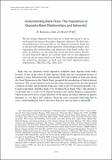Understanding Bank Runs: The Importance of Depositor-Bank Relationships
Author(s)
Iyer, Rajkamal; Puri, Manju
DownloadIyer_Understanding bank.pdf (2.042Mb)
PUBLISHER_POLICY
Publisher Policy
Article is made available in accordance with the publisher's policy and may be subject to US copyright law. Please refer to the publisher's site for terms of use.
Terms of use
Metadata
Show full item recordAbstract
We use unique depositor-level data for a bank that faced a run to understand the factors that affect depositor behavior. We find uninsured depositors are most likely to run. Deposit insurance helps, but is only partially effective. Bank-depositor relationships mitigate runs, suggesting that relationship with depositors help banks reduce fragility. In addition, we also find that social networks matter. Finally, we find long-term effects of a solvent bank run in that depositors who run do not return back to the bank. Our results help understand the underlying dynamics of bank runs and hold important policy implications.
Date issued
2012-06Department
Sloan School of ManagementJournal
American Economic Review
Publisher
American Economic Association
Citation
Iyer, Rajkamal, and Manju Puri. “Understanding Bank Runs: The Importance of Depositor-Bank Relationships and Networks.” American Economic Review 102.4 (2012): 1414–1445. Web.
Version: Final published version
ISSN
0002-8282
1944-7981